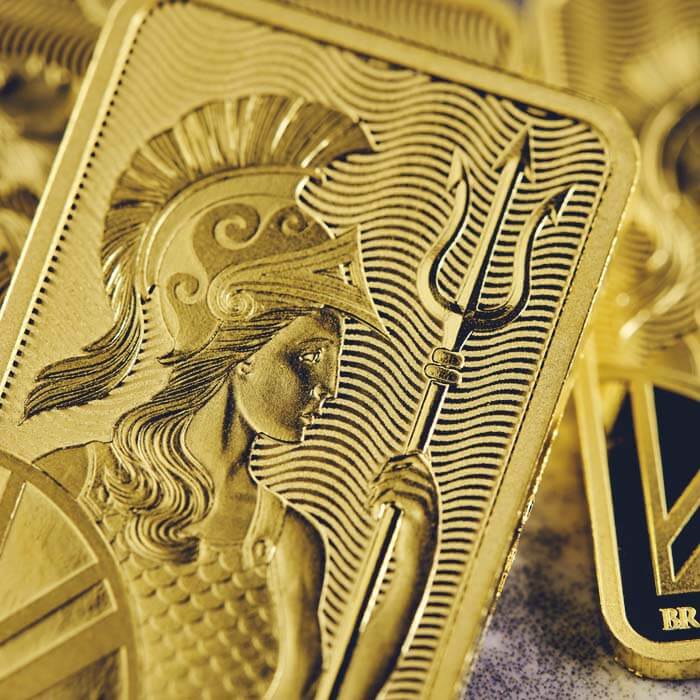- Understanding Cryptocurrencies
- Comparing Cryptocurrencies to Gold
- The Merits of Investing in Gold
- Conclusion

In recent years, Bitcoin and other cryptocurrencies have proved to be a popular option sparking the curiosity of investors across the globe. This has led many to wonder whether Bitcoin could take on a role similar to gold in an investment portfolio, with some even questioning if Bitcoin is the new gold. Whilst cryptocurrencies like Bitcoin and traditional gold investments share certain similarities – such as their limited supply and the role they play as an alternative to standard currencies – the two aren’t identical. There are critical differences that all investors should keep in mind.
Cryptocurrencies, led by the pioneering Bitcoin, have introduced a paradigm shift in how we perceive and utilise currency. They offer unique features such as decentralisation and transparency, fuelled by revolutionary blockchain technology. As a result, cryptocurrencies have gained popularity as a medium of exchange, a store of value, and even as investment assets with the potential for remarkable returns.
However, as with any investment, it is essential to consider the risks and dynamics associated with the cryptocurrency market. Comparing it to the more stable and tangible gold market allows us to appreciate the merits of investing in gold alongside cryptocurrencies. Whilst cryptocurrencies exhibit volatility and speculative tendencies, gold has stood the test of time as a reliable store of wealth and a hedge against economic uncertainties.

Understanding Cryptocurrencies
Cryptocurrencies have emerged as a transformative force in the financial landscape, offering a new way to conceptualise and utilise currency. To grasp their significance, it is crucial to delve into the fundamental aspects of cryptocurrencies and the underlying blockchain technology that powers them.
At its core, a cryptocurrency is a digital or virtual form of currency that relies on cryptographic principles for secure transactions and the creation of new units. The most well-known cryptocurrency, Bitcoin, introduced the concept of decentralised digital money, operating independently of traditional financial institutions. This decentralisation is made possible through the innovative technology called blockchain.
Blockchain serves as a distributed ledger, maintaining a transparent and immutable record of all transactions across a network of computers or nodes. This decentralised nature ensures transparency, security and resilience against fraud or tampering. Each transaction, represented by a block, is chronologically linked to previous transactions, forming an unbroken chain of information. This process prevents double-spending and eliminates the need for intermediaries, such as banks, to verify and authorise transactions.
Cryptocurrencies can offer several key features and benefits. Firstly, they enable peer-to-peer transactions, allowing individuals to transact directly without intermediaries. This is important as it aims to foster financial inclusivity, especially for regions of the world where traditional banking may be unavailable or unreliable. Additionally, cryptocurrencies can facilitate faster and more efficient cross-border transactions, eliminating the need for traditional intermediaries and reducing associated fees and processing times.
Moreover, cryptocurrencies provide an alternative investment avenue, appealing to individuals seeking diversification and potential high returns. The decentralised nature of cryptocurrencies and the limited supply of certain coins contribute to their value proposition. However, it is important to note that investing in cryptocurrencies also comes with risks, including market volatility and regulatory uncertainties.
Comparing Cryptocurrencies to Gold
Cryptocurrencies and gold have both similarities and fundamental differences that distinguish them as investment assets. Understanding these distinctions is crucial for investors navigating their respective markets.
Both cryptocurrencies and gold have limited supply, contributing to their perceived value. Cryptocurrencies like Bitcoin have predetermined maximum supplies, whilst gold’s supply gradually increases through mining operations. Gold’s supply expansion is relatively stable, whilst cryptocurrencies can vary in supply dynamics across different tokens.
A key distinction between cryptocurrencies and gold lies in their tangibility. Gold is a physical asset with intrinsic qualities like rarity and durability, which can be held in various forms such as bars, coins or jewellery. Cryptocurrencies, on the other hand, exist solely in digital form on decentralised ledgers called blockchains. Whilst intangible, cryptocurrencies can offer seamless global transactions and potential applications beyond traditional financial systems.
The sources of demand and ownership dynamics also differ between gold and cryptocurrencies. Gold enjoys diverse demand from various sectors like investment, industry and jewellery. Individual investors, institutions and central banks recognise gold’s value as a store of wealth. In contrast, cryptocurrencies primarily attract investment-focused demand, with ownership concentrated among enthusiasts, speculators and technologically inclined individuals.
These differences in demand and ownership dynamics influence the behaviour and volatility of gold and cryptocurrencies. Gold’s broader range of demand contributes to a more stable and liquid market, whilst cryptocurrencies may experience more pronounced price fluctuations due to the sentiment and trading activity of a smaller investor base.
By recognising these distinctions, investors can make informed decisions about the role of cryptocurrencies and gold in their portfolios. Understanding the sources of demand, supply dynamics, tangibility and ownership patterns helps investors navigate the unique characteristics and dynamics of each asset class.

The Merits of Investing in Gold
Investing in gold can offer numerous advantages, making it a prudent strategy for many for preserving wealth and diversifying investment portfolios. The merits of including gold in an investment portfolio stem from its historical significance, its role as a hedge against economic uncertainties, and its unique characteristics as a tangible and valuable asset.
Gold generally serves as a reliable store of wealth, demonstrating its resilience during economic crises, periods of inflation and market volatility. Its ability to retain value and act as a hedge against currency fluctuations and geopolitical risks makes it an attractive asset for long-term wealth preservation. By including gold in an investment portfolio, investors could benefit from its potential to preserve purchasing power and reduce overall portfolio volatility, thanks to its low or negative correlation with traditional asset classes like stocks, shares and bonds.
The liquidity and well-established market of gold further contribute to its merits as an investment. Gold can be easily bought, sold and traded in various forms, including gold bars, coins and exchange-traded funds (ETFs). This liquidity ensures investors can enter or exit positions quickly and efficiently, providing flexibility in managing their investments.
Gold’s historical role as a hedge against economic downturns and inflationary pressures adds to its appeal. During times of economic instability or financial crises, gold is sought after for its safety and stability. Its limited supply, coupled with its perceived value as a store of wealth, positions it as a potential safe haven asset. Inflation erodes the value of fiat currencies, but gold’s inherent tangible nature helps it maintain or increase its value over time, making it an attractive option for protecting against the erosive effects of inflation.
Additionally, gold’s tangible nature and cultural significance set it apart from other investment assets. Its physical presence offers a sense of tangibility and security, appealing to investors who value the tactile nature of wealth. Moreover, gold holds cultural and historical significance, carrying strong connotations in various societies. Its enduring allure and desirability contribute to its sustained demand and market stability.
Conclusion
In conclusion, cryptocurrencies and gold offer distinct investment opportunities. Cryptocurrencies provide potential for high returns but require careful risk management due to volatility. Gold, on the other hand, can offer a level of stability, wealth preservation and a more recognised, tangible asset with cultural significance.
Understanding the basics of cryptocurrencies and comparing them to the stable gold market allows investors to appreciate the unique characteristics and benefits of each asset. The decision to invest in cryptocurrencies, gold, or a combination depends on individual risk tolerance, investment goals and portfolio diversification strategies.
Ultimately, whether embracing the innovation of cryptocurrencies or relying on the stability of gold, a thoughtful and informed approach will navigate the ever-evolving financial landscape.
The contents of this article, accurate at the time of publishing, are for general information purposes only, and do not constitute investment, pensions, legal, tax, or any other advice. Before making any investment or financial decision, you may wish to seek advice from your financial, pensions, legal, tax and/or accounting advisors.
You might also like

Investing in Precious Metals Online: A Step-by-Step Guide
Read More
Understanding the Market
Read More
Digital Gold – A New Age Investment Option
Read More
Digital Assets – An Introductory Guide
Read More
Child Savings Accounts
Read More
Creating a Family Investment Plan
Read More
Exploring Alternative Investments
Read More
Family Investments
Read More
Family Saving
Read More
How to Choose the Best Online Investment Platform
Read More
Investing for Children
Read More
Investing for the Future
Read More
Investing in Gold for the Long Term
Read More
Securing Your Financial Future
Read More
The Power of Diversification
Read More
Understanding Commodities and Their Role in Investment Portfolios
Read More